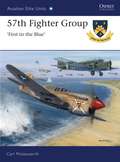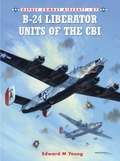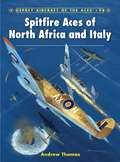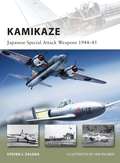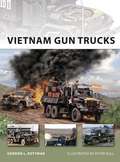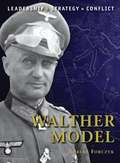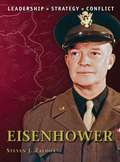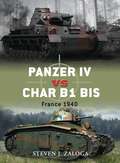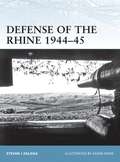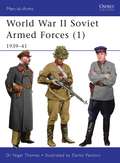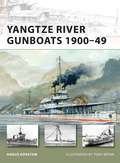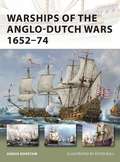- Table View
- List View
57th Fighter Group: First in the Blue (Aviation Elite Units #39)
by Jim Laurier Carl MolesworthOrganized in January 1941, just as the United States was building up military forces for its inevitable entry into World War II, the 57th Fighter Group was the first USAAF fighter unit to go into action in North Africa. It went on to establish a number of other 'firsts' during its illustrious combat history in this theatre. Flying P-40 Warhawks, the pilots of the 57th entered combat in August 1942 and fought throughout the final Allied advance from El Alamein through the Axis surrender in Tunisia, the capture of Sicily and the invasion of Italy. Converting to the P-47D Thunderbolt in late 1943, the 57th continued pounding the retreating Axis forces in Italy until the end of the war in Europe. The 57th Fighter Group produced a number of aces during the war, and was also recognized for its pioneering achievements in the fighter-bomber role.
B-24 Liberator Units of the CBI (Combat Aircraft)
by Mark Styling Edward M. YoungThe B-24 Liberator was the mainstay of the US Army Air Force's strategic bombing effort in the China-Burma-India (CBI) Theatre from 1942 until the end of the war in 1945. With longer range and a greater load-carrying capacity than the B-17, the B-24 was well-suited to the demands of the CBI. The CBI's two air forces, the Tenth in India and the Fourteenth in China, each had one heavy bomb group equipped with Liberators. These two groups, the 7th and the 308th, carried the war to the Japanese across China and South East Asia, flying over some of the most difficult terrain in the world. The 308th had the added burden of having to carry its own fuel and bombs over the Himalayan 'Hump' from India to China in support of its missions. Despite the hardships and extreme distances from sources of supply, both units compiled a notable record, each winning two Distinguished Unit Citations.
Spitfire Aces of North Africa and Italy (Aircraft of the Aces)
by Chris Davey Andrew ThomasAlthough most famous for their role in the Battle of Britain, many Spitfire squadrons also served in the Mediterranean theatre, aiding the Allied victories in North Africa and later in the invasion of Italy. Numerous pilots, both Royal Air Force and South African Spitfire squadrons, made ace during these engagements. This book tells their story.
Aces of the Legion Condor (Aircraft of the Aces #99)
by Jim Laurier Robert ForsythFor Germany, the Spanish Civil War proved a perfect testing ground for new technologies and tactics. During the war, some 19,000 German 'volunteers' formed an aviation group called the Legion Condor in support of the fascists. Originally flying He-51s, they were soon upgraded to 109s. These fighters proved dominant in the Spanish skies, and many members of the legion scored five or more kills during the fighting.
Mark V Tank (New Vanguard)
by Henry Morshead David FletcherAlthough, to the casual eye, all British tanks of World War I look much the same, the Mark V is quite outstanding and has a strong claim to be the tank that won the Great War. In this title, renowned tank expert David Fletcher examines the technological developments that made this tank excel where others had failed, and the reasons why it gave the British the upper hand over the Germans on the battlefield and why it was adopted by the US Tank Corps. Accompanied by detailed artwork showing the design changes that allowed the Mark V to breach the widest German trenches, this title is an excellent resource for the study of the armour of World War I.
Kamikaze: Japanese Special Attack Weapons 1944–45 (New Vanguard)
by Steven J. Zaloga Ian PalmerThe destruction of much of the remainder of the Japanese fleet and its air arm in the later half of 1944 left the Japanese Home Islands vulnerable to attack by US naval and air forces. In desperation, the Imperial Japanese Navy proposed using "special attack†? formations, or suicide attacks. These initially consisted of crude improvisations of conventional aircraft fitted with high-explosive bombs that could be crashed into US warships. Called "Divine Wind†? (Kamikaze), the special attack formations first saw action in 1944, and became the scourge of the US fleet in the battles for Iwo Jima and Okinawa in 1945. In view of the success of these attacks, the Japanese armed forces began to develop an entire range of new special attack weapons. This book will begin by examining the initial kamikaze aircraft attacks, but the focus of the book will be on the dedicated special attack weapons developed in 1944. It also covers specialized suicide attack weapons such as anti-tank lunge mines.
Vietnam Gun Trucks (New Vanguard)
by Peter Bull Gordon L. RottmanWhile Vietnam is usually perceived as an infantry war, with US forces deploying by helicopter, the long supply lines that led to their inland bases had to be traveled by ground vehicles. The 8th and 48th Transportation Groups were responsible for hauling supplies through the long, dangerous roads of Vietnam, and they often found themselves the target of ambushes, attacks, and sniping. In response to this, vehicle crews began to arm trucks with machine guns and armour them with sandbags. While these proved less than ideal, the concept was considered valid, and more and more "gun trucks†? appeared, sporting heavier weapons and armor. Written by a Vietnam veteran, this book traces the development of these gun trucks from the jury-rigged originals to the powerful armoured vehicles that appeared later in the war.
Walther Model: Leadership, Strategy, Conflict (Command #15)
by Robert Forczyk Adam HookThis volume details the military career and accomplishments of Walther Model, the youngest Generalfeldmarschall in the Wehrmacht in World War II and Hitler's favourite commander. Model was a tough and tenacious commander, particularly when on the defensive, and his career rise was virtually unprecedented in German military history. Model really made his mark late in the war, when time was already running out for the Third Reich, but time and again he was rushed from one crumbling front to the next and succeeded in temporarily restoring the situation. Above all, Model deserves recognition as one of the great defensive commanders of modern military history.
Eisenhower (Command)
by Steven J. Zaloga Steve NoonDwight Eisenhower represented a fundamentally new type of modern military commander. Eisenhower was a manager commander, whose grasp of the politics and large-scale tactics of battle were uniquely suited to leading the huge coalition of forces that fought in Europe during the Second World War. Educated at West Point, Eisenhower rose to his position as Supreme Commander of the Allied Expeditionary Force through a series of powerful contacts and his natural aptitude for leadership and large scale tactical planning. This book analyses how Eisenhower's tactics and political astuteness helped him successfully lead the invasion of Europe, how he coaxed contradictory parties into supporting his policies and how he triumphed in his now infamous clash with Montgomery. Uniquely, the author goes on to describe how Eisenhower's military influence continued when he became President, as his leadership and vision were tested by the outbreak of the Cold War.
Marlborough: Leadership, Strategy, Conflict (Command)
by Angus Konstam Graham TurnerJohn Churchill, 1st Duke of Marlborough, is one of the great commanders of history. Using his great charm and diplomatic skills he was able to bind troops from various European states into a cohesive army that won a string of victories over the French armies of King Louis XIV, the first of which was perhaps his most spectacular triumph – the battle of Blenheim. Other great victories followed, but political and social turmoil proved harder opponents to defeat. This book provides a detailed look at the many highs and lows in the career of the most successful British general of his era.
Heinz Guderian: Leadership, Strategy, Conflict (Command)
by Adam Hook Pier Paolo BattistelliThis book gives a focused, military biography of Heinz Guderian, perhaps the most highly respected tank commander of World War II. Guderian was a typical product of the Prussian military elite; the son of a general in the army, there was little doubt that he would follow in his father's footsteps. Some consider Guderian to be the founding father of blitzkrieg warfare, and he certainly brought the whole concept to public attention and prominence, chiefly through the publication of his book Achtung Panzer in 1937. He commanded the XIX (Motorized) Army Corps in the 1939 Polish campaign, and Panzergruppe Guderian during Operation Barbarossa. In March 1943 he became chief inspector of the Panzer forces, but even the great tank commander could achieve little more than to delay the inevitable defeat of Germany.
Lawrence of Arabia (Command)
by Giuseppe Rava David MurphyThomas Edward Lawrence, more popularly known as Lawrence of Arabia, is remembered today more for his immortalization on stage and screen rather than for his dramatic exploits in the Middle East during the First World War. This book shines a light on his military achievements, his major campaigns and the impact that his influence had on shaping the war in the Middle East. Lawrence quickly rose to prominence following the outbreak of the Arab Revolt in 1916. His skills in Arab languages helped him co-ordinate Navy support in an effort to regain captured coastal ports, whilst gathering widespread local support and building up the Arab Northern Army. He pioneered new tactics, which would shape British strategy four decades later, recognising the importance of aircraft, mobile artillery and armour in desert warfare. In two short years the obscure staff officer had attained the rank of full colonel and helped to shape the outcome of the war in the Middle East.
Panzer IV vs Char B1 bis: France 1940 (Duel)
by Steven J. Zaloga Richard ChasemoreThe Battle of France in 1940 involved the first large-scale tank-against-tank battles in history. The massive clashes at Stonne, Hannant, and Gembloux involved hundreds of tanks on both sides, yet have faded from memory due to the enourmity of the French defeat. This book examines two of the premier opposing tanks of the Wehrmacht and the French Army, the German PzKpfw IV and the French Char B1 bis. With a complete history of the design, development, and deployment of these armoured fighting vehicles, the story of these great battles is once again brought to life.
Italian Battleships of World War II (New Vanguard)
by Paul Wright Mark StilleItaly's navy, the Regia Marina was the fourth-largest naval force in the world at the outbreak of World War II, and yet is often overlooked and largely discounted as ineffective. In general the fleet was made up of obsolete vessels, lacked radar functionality, and had a reputation for indiscipline and poorly trained crews. The complex and bureaucratic command system imposed on the fleet further hampered its effectiveness. In this book, Mark Stille details why the Italian battleships were able to maintain a solid reputation, examining their impressive designs and the courage and determination of the fleet at Calabria, Sirte, Cape Spartiveto and Cape Matapan, all illustrated with stunning photographs from the Italian Navy's own archives.
The Bismarck 1941: Hunting Germany’s greatest battleship (Campaign)
by Paul Wright Angus KonstamThe break of the German battleship Bismarck into the North Atlantic in May 1941 was one of the most dramatic episodes of World War II. It began with a battle between the Bismarck and the British battleship Prince of Wales and the heavy cruiser Hood. The Hood was blown to pieces, while the battered Prince of Wales managed to escape. The British then focused all of their resources on hunting the mighty German battleship and eventually brought her down.
Defense of the Rhine 1944–45 (Fortress)
by Steven J. Zaloga Adam HookThe Rhine River represented the last natural defensive barrier for the Third Reich in the autumn of 1944. Although Hitler had been reluctant to allow the construction of tactical defence lines in France, the final defense of the Reich was another matter. As a result, construction of a Rhine defence line began in September 1944. Steven J. Zaloga examines the multiple phases of construction undertaken to strengthen the Westwall (Siegfried Line), to fortify many of the border villages, and finally to prepare for the demolition of the Rhine bridges. Using detailed maps, colour artwork, and expert analysis, this book takes a detailed look at Germany's last line of defence.
St Mihiel 1918: The American Expeditionary Forces’ trial by fire (Campaign)
by Howard Gerrard David BonkAt 1:00 am on September 12, 1918, accompanied by rain and lightning, the American Army launched its first major offensive of World War I. Supported by French Colonial troops, the American IV and V Corps burst through the weakened German line at St. Mihiel and seized numerous objectives while taking over 16,000 prisoners and capturing over 400 guns. Although American tactics remain suspect, and the operation cost 7,000 US casualties, the battle was heralded as a huge Allied victory. More importantly, it demonstrated to the French and British that the Americans were capable of large-scale, combined-arms operations. Packed with photos, artwork and battle maps, this book explains the entire offensive in detail.
Fortress Monasteries of the Himalayas: Tibet, Ladakh, Nepal and Bhutan (Fortress #104)
by Peter Dennis Peter HarrisonThe spread of Buddism and Tibetan secular power throughout the Himalayas led to a distinctive style of fortifications not found anywhere else. This book looks at Himalayan fortifications, from their creation in the Middle Ages to their destruction and capture by the Chinese in the 20th century.
Sniper Rifles: From the 19th to the 21st Century (Weapon)
by Peter Dennis Martin PeglerA technical outline of the history of the sniper rifle, from its introduction in warfare during the Napoleonic wars, through the US Civil War to its current apogee as the most frequently used combat rifle in Iraq and Afghanistan. This book details the development of ammunition, different weapons types including single shot, magazine loading and semi-automatic, as well as the introduction and use of optical sights. Martin Pegler, a leading expert on the history of sniping and former Senior Curator of Firearms at the Royal Armouries Leeds, also details the current advances in technology, such as laser range-finding sights and night vision devices. Using first-hand accounts, the book brings the dangerous world of the sniper to life revealing their training and concealment techniques as well as their mastering of their weapon of choice.
World War II Soviet Armed Forces: 1939–41 (Men-at-Arms)
by Nigel Thomas Darko PavlovicThis book is a detailed analysis of the Soviet Army at the outbreak of World War II, including the Red Army's campaigns against Japan on the Manchurian plains as well as in Finland. It covers the Red Army's first operations during Operation Barbarossa when the Red Army was forced to defend Mother Russia against the German onslaught. It offers a breakdown of all the armed forces including the army, air force, paratroopers, navy and NKVD troops. In particular it covers the evolution of uniforms, equipment and insignia with the introduction of new regulations in 1935 and 1940.
Chinese Warlord Armies 1911–30 (Men-at-Arms)
by Stephen Walsh Philip JowettDefeated in the Sino-Japanese War 1894–95 and the Boxer Rebellion of 1900, Imperial China collapsed into revolution and a republic was proclaimed in 1912. From the death of the first president in 1916 to the rise of the Nationalist Kuomintang government in 1926, the differing regions of this vast country were ruled by endlessly forming, breaking and re-forming alliances of regional generals who ruled as 'warlords'. These warlords acted essentially as local kings and much like Sengoku-period Japan, fewer, larger power-blocks emerged, fielding armies hundreds of thousands strong. In the midto late 1920s some of these regional warlords. This book will reveal each great warlord as well as the organization of their forces which acquired much and very varied weaponry from the west including the latest French air force bombers. They were also joined by Japanese, White Russian and some Western soldiers of fortune which adds even more colour to a fascinating and oft-forgotten period.
King Tiger vs IS-2: Operation Solstice 1945 (Duel)
by Peter Dennis Jim Laurier David R. HigginsThis book examines the technology and strategy that defined the outcome of the battles between the King Tiger and the IS-2. The Soviets had been quick to develop tanks that could fight the Tiger on an equal footing, but these were developed as part of a completely different strategy than that employed by the Germans. The King Tiger was a modern marvel, and remained unmatched in one-on-one combat. Technologically superior, with greater firepower and better armour than the Soviet IS-2, the King Tiger was a formidable opponent. However, the IS-2 was lighter, more manoeuvrable and most importantly, far more numerous. With overwhelming numerical superiority the Soviets were able to simply overwhelm their opponents, negating the technical superiority of the King Tiger
Yangtze River Gunboats 1900–49 (New Vanguard)
by Tony Bryan Angus KonstamFrom the end of the 19th century through the first half of the 20th, most Western powers maintained a naval presence in China. These gunboats protected traders and missionaries, safeguarded national interests, and patrolled Chinese rivers in search of pirates. It was a wild, lawless time in China as ruthless warlords fought numerous small wars to increase their power and influence. This book covers the gunboats of all the major nations that stationed naval forces in China, including America, Britain, France, Germany, Italy, Portugal, and Japan, and looks at such famous incidents as the Japanese bombing of the USS Patay and the dramatic escape of the HMS Amethyst from Communist forces in 1947, which marked the end of the gunboat era.
Warships of the Anglo-Dutch Wars 1652–74 (New Vanguard)
by Peter Bull Angus KonstamThree times during the 17th century, England and Holland went to war as part of an ongoing struggle for economic and naval supremacy. Primarily fought in the cold waters of the North Sea and the English Channel, the wars proved revolutionary in their impact upon warship design, armament, and naval tactics. During this time, the warship evolved into the true ship-of-the-line that would dominate naval warfare until the advent of steam power. This book traces the development of these warships in the context of the three Anglo–Dutch wars.
The Fortifications of Verdun 1874–1917 (Fortress #103)
by Brian Delf Clayton DonnellThe ring of fortifications protecting the city of Verdun on the Meuse River would become critical in the infamous battle of World War I. This book examines these fortifications, including the famous forts of Douaumont and Vaux that saw some of the fiercest fighting during the battle.
